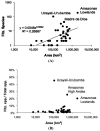Aquatic Biodiversity in the Amazon: Habitat Specialization and Geographic Isolation Promote Species Richness
- PMID: 26486313
- PMCID: PMC4513461
- DOI: 10.3390/ani1020205
Aquatic Biodiversity in the Amazon: Habitat Specialization and Geographic Isolation Promote Species Richness
Abstract
The Neotropical freshwater ichthyofauna has among the highest species richness and density of any vertebrate fauna on Earth, with more than 5,600 species compressed into less than 12% of the world's land surface area, and less than 0.002% of the world's total liquid water supply. How have so many species come to co-exist in such a small amount of total habitat space? Here we report results of an aquatic faunal survey of the Fitzcarrald region in southeastern Peru, an area of low-elevation upland (200-500 m above sea level) rainforest in the Western Amazon, that straddles the headwaters of four large Amazonian tributaries; the Juruá (Yurúa), Ucayali, Purús, and Madre de Dios rivers. All measures of fish species diversity in this region are high; there is high alpha diversity with many species coexisting in the same locality, high beta diversity with high turnover between habitats, and high gamma diversity with high turnover between adjacent tributary basins. Current data show little species endemism, and no known examples of sympatric sister species, within the Fitzcarrald region, suggesting a lack of localized or recent adaptive divergences. These results support the hypothesis that the fish species of the Fitzcarrald region are relatively ancient, predating the Late Miocene-Pliocene (c. 4 Ma) uplift that isolated its several headwater basins. The results also suggest that habitat specialization (phylogenetic niche conservatism) and geographic isolation (dispersal limitation) have contributed to the maintenance of high species richness in this region of the Amazon Basin.
Keywords: freshwater fishes; geodispersal; species diversity; species richness; stream capture; tropical rainforest; vicariance.
Figures











References
-
- Gentry A.H. Neotropical floristic diversity—Phytogeographical connections between Central and South America, Pleistocene climatic fluctuations, or an accident of the Andean orogeny? Ann. Mo. Bot. Gard. 1982;69:557–593.
-
- Moritz C., Patton J.L., Schneider C.J., Smith T.B. Diversification of rainforest faunas: An integrated molecular approach. Annu. Rev. Ecol. Syst. 2000;31:533–563.
-
- Lundberg J.G., Kottelat M., Smith G.R., Stiassny M.L.J., Gill A.C. So many fishes, so little time: An overview of recent ichthyological discovery in continental waters. Ann. Mo. Bot. Gard. 2000;87:26–62.
-
- Leveque C., Oberdorff T., Paugy D., Stiassny M.L.J., Tedesco P.A. Global diversity of fish (Pisces) in freshwater. Hydrobiologia. 2008;595:545–567.
-
- Albert J.S., Petry P., Reis R.E. Major Biogeographic and Phylogenetic Patterns. In: Albert J.S., Reis R.E., editors. Historical Biogeography of Neotropical Freshwater Fishes. University of California Press; Berkeley, CA, USA: 2011. pp. 21–57.
LinkOut - more resources
Full Text Sources

